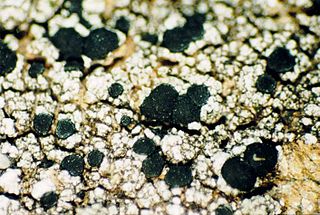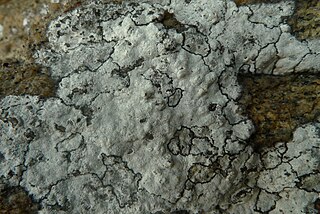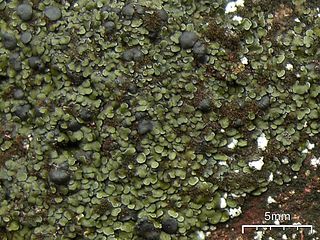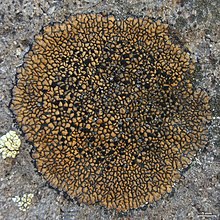
The Lecanoraceae are a family of lichenized fungi in the order Lecanorales. Species of this family have a widespread distribution.

Ochrolechia is a genus of crustose lichens in the family Ochrolechiaceae. These lichens typically form uneven, often thick, crust-like growths on various surfaces and are characterised by their white to pale grey thalli, which may have a greenish tint. The genus has a long evolutionary history, with fossils dating back to the Paleogene period, about 34 million years ago. Ochrolechia species have disc-like apothecia, which are usually yellowish or brownish-pink and often covered with a fine white powdery coating. The genus is widely distributed and includes both common and rare species, with some found in extreme environments such as arctic and alpine regions. Ochrolechia lichens produce diverse secondary metabolites, including orcinol depsides, depsidones, and xanthones.
Lithographa is a genus of lichenized fungi in the family Xylographaceae. The genus was circumscribed in 1857 by Finnish botanist William Nylander, with Lithographa petraea assigned as the type species. This species is now known as Lithographa tesserata.

Cliostomum is a genus of lichenized fungi in the family Ramalinaceae. It has about 25 species.

Lopadium is a genus of lichen-forming fungi in the monotypic family Lopadiaceae, which is in the order Lecideales. The genus contains 10 species. Lopadium was circumscribed by German lichenologist Gustav Wilhelm Körber in 1855.

Roccellographa is a genus of lichen-forming fungi in the family Roccellographaceae. The genus was circumscribed by Austrian lichenologist Julius Steiner in 1902, with Roccellographa cretacea assigned as the type, and at that time, the only species. Three additional species have since been transferred to the genus from other genera.

Miriquidica is a genus of lichen in the family Lecanoraceae. The genus was circumscribed in 1987 by lichenologists Hannes Hertel and Gerhard Rambold, with Miriquidica complanata assigned as the type species. According to Dictionary of the Fungi, the widespread genus contains 23 species, found predominantly in arctic-alpine regions.
Sagiolechia is a genus of lichen-forming fungi in the family Sagiolechiaceae. The genus was circumscribed by lichenologist Abramo Bartolommeo Massalongo in 1854, who assigned Sagiolechia protuberans as the type species. The family Sagiolechiaceae was proposed in 2010 to contain Sagiolechia as the type genus, and genus Rhexophiale; molecular phylogenetic analysis showed that these two genera formed a distinct clade in the Ostropales.

Spilonema is a genus of lichen-forming fungi in the family Coccocarpiaceae. The genus was circumscribed by Jean-Baptiste Édouard Bornet in 1856.

The Lecideaceae are a family of lichen-forming fungi in the order Lecideales. It contains about 30 genera and roughly 250 species. A major distinguishing characteristic of the family is the lecanoroid form of the fruiting bodies: typically circular, dark, and without a thalline margin. Most species in the family are lichenised with green algae, although a few species, scattered amongst several genera, are lichenicolous—they live on other lichens. Lecideaceae lichens tend to grow on rocks, wood, and soil. Several Lecideaceae species accelerate the weathering of rock surfaces, a process known as pedogenesis, by extending their hyphae into cracks and expelling rock flakes. This contributes to significantly faster weathering rates in certain environments, impacts various materials from natural rocks to man-made Sekishu roof tiles, and involves key biomolecules identified for survival and biodeterioration, including compounds to withstand intense ultraviolet radiation.

Porpidia is a genus of crustose lichens in the family Lecideaceae. Porpidia species primarily inhabit siliceous rocks, pebbles, and stonework, with rare occurrences on bark, wood, and compacted soil. The thallus, or body of the lichen, varies in appearance from thick and crusty to barely visible. It may form a continuous layer or develop cracks resulting in a segmented, areolate structure. The colour of the thallus ranges from grey and white to orange.

Palicella is a genus of crustose lichens in the family Lecanoraceae. It contains six species.

Trapeliaceae is a family of lichens in the order Baeomycetales. The family contains 12 genera and about 125 species.

Halecania is a genus of fungi in the family Leprocaulaceae. It has 22 species. The genus was circumscribed by Austrian lichenologist Michaela Mayrhofer in 1987, with Halecania alpivaga assigned as the type species. She created Halecania to contain species, formerly placed in Lecania, with the following characteristics: uniformly amyloid apical domes, paraphyses with dark brown apical caps, and halonate ascospores.

Xylographaceae is a family of lichen-forming fungi in the order Baeomycetales. It contains four genera and 25 species.
Toensbergia is a genus of lichen-forming fungi in the family Sporastatiaceae. The genus was circumscribed by Mika Bendiksby and Einar Timdal in 2013. The genus name honours Norwegian lichenologist Tor Tønsberg, "in appreciation of his important work on sorediate, corticolous lichens". The type species is Toensbergia leucococca, which was formerly classified in genus Hypocenomyce, presumably due to its resemblance to Hypocenomyce xanthococca.

Hymeneliaceae is a family of lichen-forming fungi in the order Baeomycetales. It contains three genera and about 40 species. The family was circumscribed by German lichenologist Gustav Wilhelm Körber in 1855.
Shackletonia is a genus of lichen-forming fungi in the family Teloschistaceae. The species in the Shackletonia genus are lichenicolous and muscicolous, and known from Antarctica and southern Patagonia.
Protothelenella is a genus of fungi in the family Protothelenellaceae. It contains 11 species, some of which form lichens. Protothelenella species have a crustose thallus with spherical to pear-shaped, dark brown to blackish perithecia. Microscopic characteristics of the genus include bitunicate asci with an amyloid tholus, and ascospores that are colourless and contain multiple internal partitions. Some species grow on acidic substrates including rocks, soil, bryophytes, plant detritus or rotten wood. Other species are lichenicolous (lichen-dwelling), growing on species of Solorina, Peltigera, Pseudocyphellaria, or Cladonia.

Porpidia macrocarpa is a species of saxicolous (rock-dwelling), crustose lichen in the family Lecideaceae.















